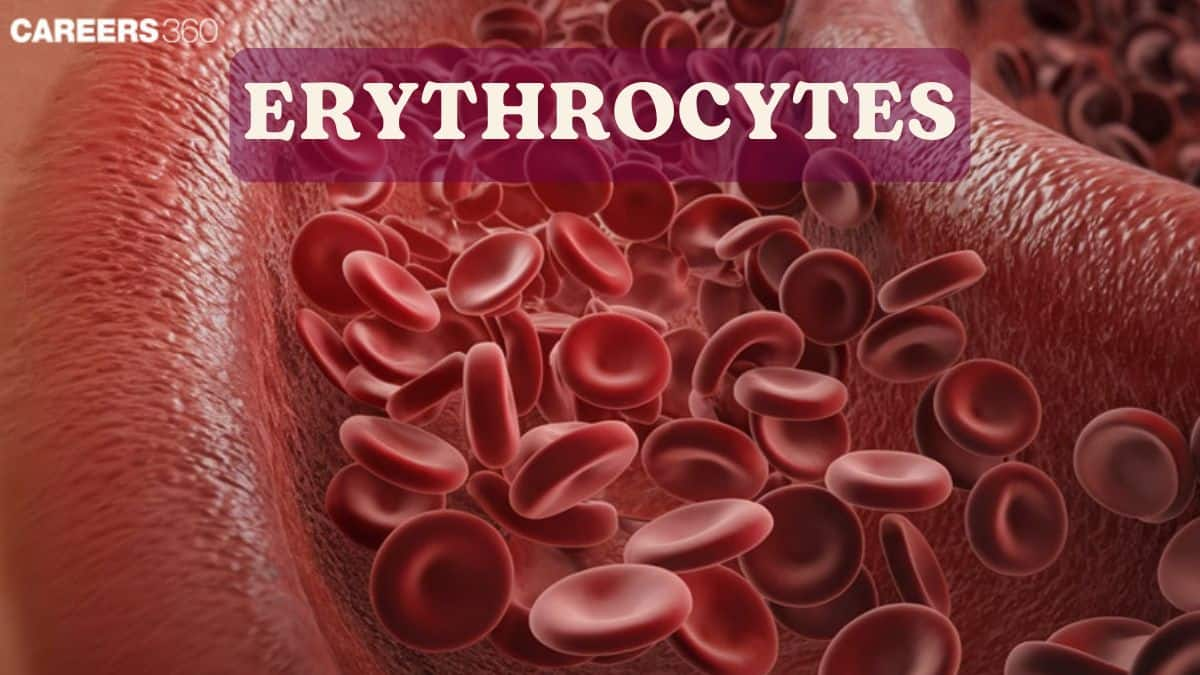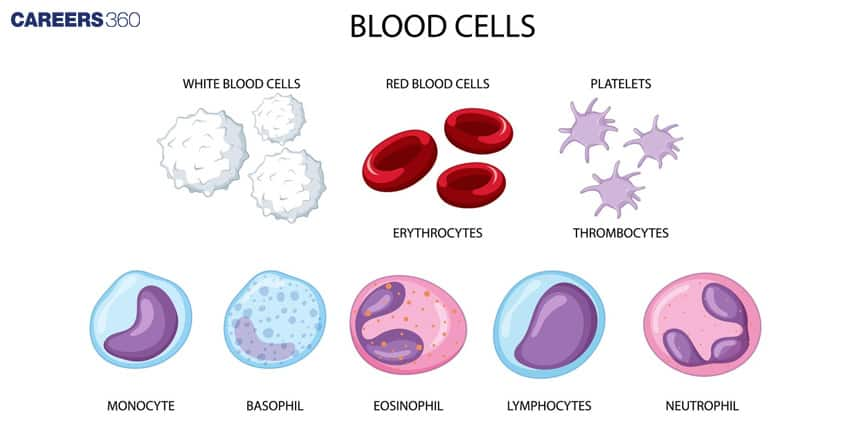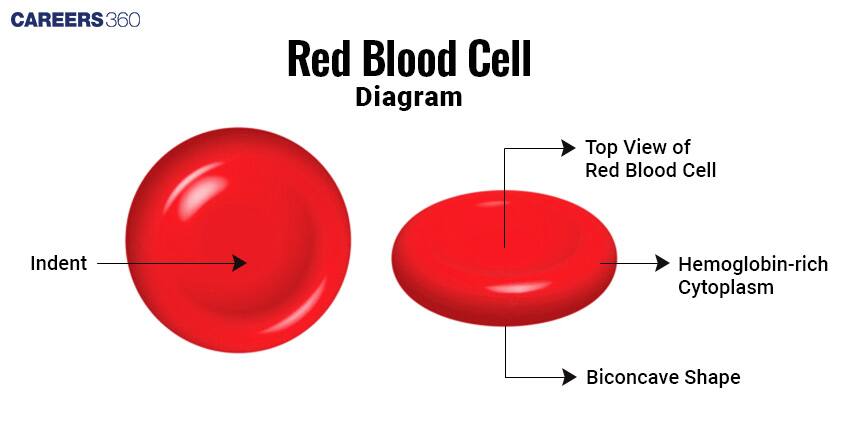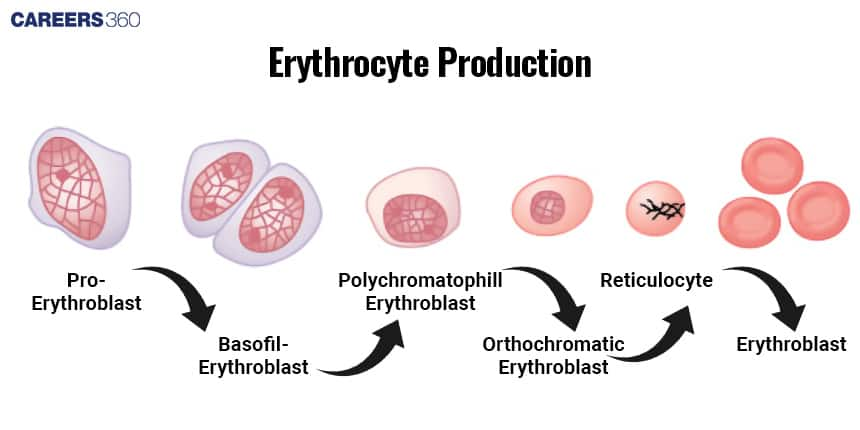Erythrocytes (Red Blood Cells)
Erythrocytes, or red blood cells (RBCs), are biconcave, nucleus-free cells that transport oxygen and carbon dioxide in blood. Produced in bone marrow and lasting ~120 days, they are crucial in respiration and clinical diagnosis.
This Story also Contains
- What Are Erythrocytes?
- Structure of Erythrocytes
- Function of Erythrocytes
- Production Of Erythrocytes
- Disorders of Erythrocytes
- Erythrocyte Destruction and Recycling
- Erythrocytes in Health and Disease
- Erythrocytes NEET MCQs (With Answers & Explanations)
- Recommended video on Erythrocytes (Red Blood Cells)

What Are Erythrocytes?
Erythrocytes or red blood cells (RBCs) are the most abundant type of blood cells. They transport oxygen from the lungs to the tissues of the body and carbon dioxide from the tissues back to the lungs. RBCs contain the oxygen-carrying protein hemoglobin, which is a pigment that gives whole blood its red color.
A healthy adult male has about 5.4 million red blood cells per microliter (μL) of blood, and a healthy adult female has about 4.8 million. To maintain normal numbers of RBCs, new mature cells enter the circulation at the rate of at least 2 million per second, a pace that balances the equally high rate of RBC destruction.

Structure of Erythrocytes
The structure of erythrocytes has following characteristics:
Biconcave Shape
RBCs are biconcave discs with a diameter of 7–8 μm. The biconcave shape of the erythrocytes increases the surface area of the cell, which helps in the exchange of gases.
RBCs lack a nucleus and other organelles and can neither reproduce nor carry on extensive metabolic activities. This leaves more space that can be occupied by haemoglobin.
Cell Membrane and Flexibility
The plasma membrane is both strong and flexible, which allows them to deform without rupturing as they squeeze through narrow blood capillaries.
Certain glycolipids in the plasma membrane of RBCs are antigens that account for the various blood groups such as the ABO and Rh groups.
Haemoglobin Composition
A hemoglobin molecule consists of a protein called globin and a nonprotein pigment called a heme. Each hemoglobin molecule binds four oxygen molecules. Therefore, it is in-charge of oxygen and carbon dioxide transport.

Function of Erythrocytes
The functions of erythrocytes are:
Oxygen and Carbon Dioxide Transport
Erythrocytes transport oxygen from the lungs to the body's tissues and carbon dioxide from the body's tissues to the lungs to be exhaled.
Blood pH and Buffering
RBCs also contain the enzyme carbonic anhydrase, which catalyzes the conversion of carbon dioxide and water to carbonic acid, which dissociates into H+ and HCO3-. This reaction is significant as it serves as an important buffer in extracellular fluid.
Blood Type Determination
The surfaces of erythrocytes contain antigens composed of glycoproteins and glycolipids. Based on the presence or absence of various antigens, blood is categorized into different blood groups. There are more than 100 antigens that can be detected on the surface of red blood cells.
Production Of Erythrocytes
Without a nucleus and other organelles, RBCs cannot synthesize new components to replace damaged ones. Ruptured red blood cells are removed from circulation and destroyed by macrophages in the spleen and liver, and the breakdown products are recycled and used in numerous metabolic processes, including the formation of new red blood cells.
Erythropoiesis Process
Erythropoiesis ensues in a few successive stages, namely, the formation of erythroid stem cells, proerythroblasts, erythroblasts, reticulocytes, and finally mature erythrocytes.
The production of RBCs starts in the red bone marrow with a precursor cell called a proerythroblast. The proerythroblast divides several times, producing cells that begin to synthesize hemoglobin.
Ultimately, a cell near the end of the development ejects its nucleus and becomes a reticulocyte. Loss of the nucleus causes the center of the cell to indent, producing a distinctive biconcave shape.
Reticulocytes retain some mitochondria, ribosomes, and endoplasmic reticulum. Reticulocytes develop into mature red blood cells within 1 to 2 days after their release from red bone marrow.

Erythrocyte Lifespan
Red blood cells live only about 100-120 days because of the wear and tear their plasma membranes undergo as they squeeze through blood capillaries.
Disorders of Erythrocytes
Several disorders related to erythrocytes are:
Anaemia
Anemia is a reduction in the number of either erythrocytes or haemoglobin, thus reducing the amount of oxygen that is delivered to the tissues of the body.
Sickle cell anaemia
Sickle cell anemia is a genetic disorder whereby the red blood cells are in the form of a sickle, thus blocking blood vessels and reducing oxygen delivery.
Thalassemia
This is a genetic disorder characterized by reduced haemoglobin synthesis, which results in anaemia.
Polycythemia
It is an increase in the number of erythrocytes, and, therefore, the blood will thicken, which obviously may cause some complications.
Erythrocyte Destruction and Recycling
The recycling occurs as follows:
Eryptosis
This refers to the programmed death of erythrocytes. Eryptosis goes on at the same rate as that of the production of erythrocytes to maintain a balanced count of the circulating erythrocytes.
Role of Macrophages
Macrophages identify old or damaged erythrocytes in the spleen, liver, and bone marrow and destroy them.
Hemoglobin Recycling
The components of haemoglobin, such as iron, are recycled by the body for use in the future while formatting the process of erythropoiesis.
Erythrocytes in Health and Disease
Erythrocytes ensure normal body function. Any change in their number, size, or shape can lead to disorders, affecting overall health.
Oxygen Delivery and Metabolism
Erythrocytes play a very crucial role in delivering oxygen to the body tissues for various metabolic processes.
Adaptation to High Altitudes
The body can increase the production of erythrocytes in response to low levels of oxygen at high altitudes to ensure adequate delivery of oxygen.
Diagnostic Significance
Erythrocyte count and haemoglobin levels are important indicators of overall health and also help in diagnosing many disorders.
Erythrocytes NEET MCQs (With Answers & Explanations)
Important topics for NEET exam are:
Structure and characteristics of RBCs
Production of RBCs (sequential order)
Disorders of RBCs
Adaptations at high altitudes.
Practice Questions for NEET
Q1. Largest RBCs are found in
Pisces
Amphibians
Reptiles
Mammals
Correct answer: 2) Amphibians
The largest red blood cells (RBCs) are found in amphibians, while the smallest RBCs are found in mammals. In mammals, RBCs are biconcave in shape, which helps increase the surface area for gas exchange and enables flexibility as they move through small capillaries.
Hence, the correct option is 2) Amphibians
Q2. Erythropoietin hormone which stimulates R.B.C. formation is produced by :
Alpha cells of pancreas
The cells of rostral adenohypophysis
The cells of bone marrow
Cells of the kidney
Correct answer: 4) Cells of the kidney
Explanation:
The hormone erythropoietin (EPO), which stimulates the formation of red blood cells (RBCs), is produced by the kidneys.
Erythropoietin is primarily secreted by the peritubular cells in the renal cortex of the kidneys in response to low oxygen levels in the blood (hypoxia).
It stimulates the bone marrow to increase the production of red blood cells, helping to enhance the oxygen-carrying capacity of the blood.
Hence, the correct answer is option 4) Cells of the kidney.
Q3. In Mammals,
RBCs are Nucleated
Elephant has largest RBCs
Musk deer has smallest RBCs
More than one
Correct answer: 4) More than one
Explanation:
Size of RBCs in mammals -
In mammals, the elephant has the largest RBCs while musk deer (Tragulus Javanicus) has the smallest. The size of red blood cells (RBCs) in mammals varies significantly depending on the species. Larger RBCs, such as those in elephants, enhance oxygen transport in their massive circulatory systems. Conversely, smaller RBCs, like those in the musk deer, are adapted for the species' specific metabolic and physiological needs.
Hence, the correct answer is option 4 More than one.
Also Read:
Recommended video on Erythrocytes (Red Blood Cells)
Frequently Asked Questions (FAQs)
Erythrocytes carry oxygen from the lungs to the tissues of the body and carbon dioxide from the tissues to the lungs.
The transport of oxygen and carbon dioxide by erythrocytes is done through the protein haemoglobin, which binds reversibly to these gases.
Erythrocytes live in the human body for about 100-120 days.
Anaemia is a condition where the number of erythrocytes or haemoglobin is reduced, while it is increased in polycythemia.
In response to low oxygen levels at high altitudes, the body can increase erythrocyte production to ensure adequate oxygen delivery to the tissues.